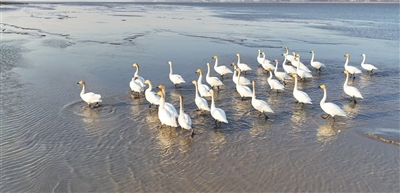Harmonious coexistence: tundra swans find sanctuary in Chongming
2025-01-23 09:02

Birdwatching enthusiast Shen Qun recently discovered a special group of "visitors"—the tundra swans—on the west side of the Nanmen Wharf in Chongming. Their graceful arrival not only added vitality and charm to the ecological island but also vividly illustrated the concept of harmonious coexistence between humans and nature.
Captured in Shen's photos, the group consists of about 30 swans, elegant in posture, with snow-white feathers and glossy black beaks. Their heads and necks are adorned with a subtle beige hue, resembling a delicate crown bestowed by nature. They leisurely stroll on the grassy shallows, dip their heads to forage in the water, and enjoy nature's gifts. Sometimes, they soar above the water, creating a dynamic ecological painting of unparalleled beauty.
Tundra swans are a nationally protected species, classified as a second-level key protected animal. They are migratory birds with high habitat requirements. Every October, they begin their southward journey to overwinter, seeking environments with clean water, expansive water bodies, abundant aquatic plants, and shallow areas.
In recent years, the construction of the world-class ecological island in Chongming has progressed steadily. The results of ecological restoration have been remarkable, with continuous improvements in environmental quality, making it an ideal habitat and migratory stopover for tundra swans and other rare birds. Statistics show that the swan population has remained around 3,000 in recent years. Each winter, these migratory birds arrive at Shanghai's first World Natural Heritage site—the Chongming Dongtan National Nature Reserve. The swans spotted near the Nanmen Wharf are part of this vast migratory group.
The "Swan Lake" landscape in Chongming has become a striking symbol of ecological civilization, showcasing the achievements of ecological protection and vividly portraying the harmonious coexistence between humans and nature.